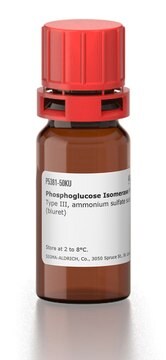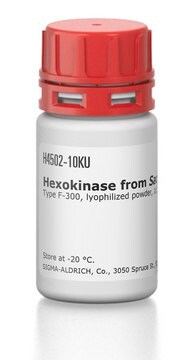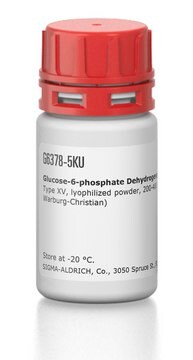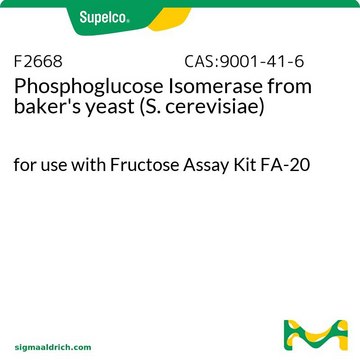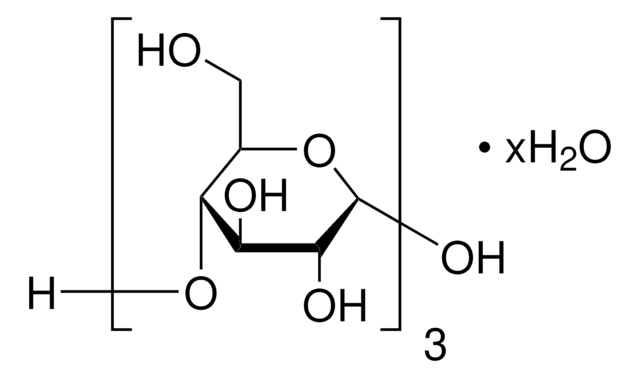P9544
Phosphoglucose Isomerase from rabbit muscle
Type XI, lyophilized powder, ≥200 units/mg protein
Sinónimos:
D-Glucose-6-phosphate ketol-isomerase, PGI, Phosphosaccharomutase
Iniciar sesiónpara Ver la Fijación de precios por contrato y de la organización
About This Item
Productos recomendados
biological source
rabbit muscle
Quality Level
type
Type XI
form
lyophilized powder
specific activity
≥200 units/mg protein
composition
protein, 70-100% biuret
storage temp.
−20°C
¿Está buscando productos similares? Visita Guía de comparación de productos
Application
Phosphoglucose Isomerase (PGI) is an enzyme crucial for the interconversion of D-glucose 6-phosphate and D-fructose 6-phosphate. PGI is responsible for the second step of glycolysis and is involved in glucogenesis. It is highly conserved in bacteria and eukaryotes. It is used in sugar assays to convert fructose to glucose . Product 9544 is type XI and is from rabbit muscle. It is useful in enzyme systems requiring low sulfate.
Biochem/physiol Actions
Phosphoglucose Isomerase fuctions as an isomerase, neuroleukin, autocrine motility factor, and a differentiation and maturation mediator . It is responsible for the photosynthetic reduction of carbon.
Unit Definition
One unit will convert 1.0 μmole of D-fructose 6-phosphate to D-glucose 6-phosphate per min at pH 7.4 at 25 °C.
Physical form
Essentially sulfate-free powder containing citrate buffer salts
signalword
Danger
hcodes
pcodes
Hazard Classifications
Resp. Sens. 1
Storage Class
10 - Combustible liquids
wgk_germany
WGK 1
flash_point_f
Not applicable
flash_point_c
Not applicable
ppe
Eyeshields, Gloves
Elija entre una de las versiones más recientes:
¿Ya tiene este producto?
Encuentre la documentación para los productos que ha comprado recientemente en la Biblioteca de documentos.
Los clientes también vieron
B K Campbell et al.
Reproduction (Cambridge, England), 140(5), 721-732 (2010-08-19)
Glucose is a critical metabolic fuel in most mammals although many foodstuffs also contain high levels of the monosaccharides, galactose and fructose. The aims of this work were to determine the insulin response to challenges of these sugars (experiment 1)
C J Jeffery et al.
Biochemistry, 39(5), 955-964 (2000-02-02)
The multifunctional protein phosphoglucose isomerase, also known as neuroleukin, autocrine motility factor, and differentiation and maturation mediator, has different roles inside and outside the cell. In the cytoplasm, it catalyzes the second step in glycolysis. Outside the cell, it serves
Veera Kainulainen et al.
Journal of bacteriology, 194(10), 2509-2519 (2012-03-06)
Glutamine synthetase (GS) and glucose-6-phosphate isomerase (GPI) were identified as novel adhesive moonlighting proteins of Lactobacillus crispatus ST1. Both proteins were bound onto the bacterial surface at acidic pHs, whereas a suspension of the cells to pH 8 caused their
Simone Frédérique Brenière et al.
PLoS neglected tropical diseases, 6(5), e1650-e1650 (2012-06-12)
The current persistence of Triatoma infestans (one of the main vectors of Chagas disease) in some domestic areas could be related to re-colonization by wild populations which are increasingly reported. However, the infection rate and the genetic characterization of the
Mohammad Amraei et al.
FEBS letters, 525(1-3), 151-155 (2002-08-07)
Phosphoglucose isomerase (PGI) is a cytosolic glycolytic enzyme that also functions as an extracellular cytokine (neuroleukin/autocrine motility factor (AMF)/maturation factor). Contrary to mammalian PGI, bacterial PGI was not internalized by the PGI/AMF receptor (gp78/AMF-R) and neither bacterial nor yeast PGI
Nuestro equipo de científicos tiene experiencia en todas las áreas de investigación: Ciencias de la vida, Ciencia de los materiales, Síntesis química, Cromatografía, Analítica y muchas otras.
Póngase en contacto con el Servicio técnico